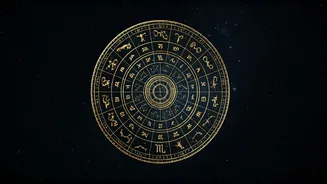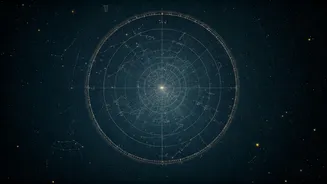Ancient Roots Unveiled
Astrology's roots trace back to ancient civilizations, with evidence suggesting its practice as early as the Bronze Age. The Babylonians developed one
of the earliest known astrological systems, observing the movements of the sun, moon, and planets to predict events. This system spread, influencing other cultures, including the Greeks and Egyptians, each adding their unique interpretations and methodologies. During the Hellenistic period, astrology evolved significantly, integrating philosophical concepts and leading to the development of horoscopes, which personalized astrological readings by linking celestial positions at the time of an individual's birth to their personality traits and life events. Over time, astrology has undergone varied periods of acceptance and rejection, but it has endured, continually evolving and adapting to new contexts, preserving its place as a significant cultural element and a subject of fascination for many around the world. Today, it continues to be practiced and reinterpreted in numerous forms, mirroring the diversity of human societies and spiritual explorations.
Core Principles Explained
Astrology operates on the premise that the positions of celestial bodies at the time of a person's birth, or at a particular event, can provide insights into their personality, life events, and potential future. The fundamental components of astrology include the zodiac signs, each associated with specific personality traits and characteristics, and the planets, each representing various aspects of human experience. Planets are mapped into astrological houses that govern distinct areas of life, from relationships and career to health and spirituality. Furthermore, the angles formed between planets, known as aspects, are believed to indicate harmony or conflict, shaping the overall character of an individual or the progression of events. These elements are combined within the birth chart, a diagram providing a snapshot of the sky at a specific time and location. The birth chart serves as the foundation for astrological readings, helping to analyze the relationships and potentials within a person's life. The accuracy of these charts is dependent upon precise calculations and interpretations by an experienced astrologer, who can weave together these components to make predictions and give guidance.
Zodiac Signs Demystified
The zodiac, a key feature of astrology, is a belt of constellations through which the sun, moon, and planets move, divided into twelve 30-degree sectors. Each sector symbolizes a specific sign of the zodiac: Aries, Taurus, Gemini, Cancer, Leo, Virgo, Libra, Scorpio, Sagittarius, Capricorn, Aquarius, and Pisces. Each sign is associated with specific dates, personality traits, and elements (fire, earth, air, and water). Aries, for instance, is known for its energy and leadership, while Taurus is associated with stability and sensuality. These signs are also linked with particular ruling planets (Mars for Aries, Venus for Taurus, etc.), which are believed to amplify the traits associated with the sign. These traits, as determined by the Sun sign, are the most commonly recognized elements of a person's astrological profile. However, a complete astrological profile incorporates the positions of the Moon, planets, and other celestial bodies in different signs to build a nuanced understanding of an individual's character and life path. The interpretations of the zodiac signs are often generalized, but astrologers will adjust these to suit a person's broader chart, integrating a number of factors to make more precise characterizations.
Planets and Their Roles
In astrology, the planets, including the sun and moon, represent different aspects of human experience and personality. The sun embodies a person's core identity, ego, and life purpose. The moon represents the emotional nature, inner self, and subconscious mind. Mercury governs communication and intellect, while Venus is associated with love, beauty, and values. Mars represents action, drive, and aggression. Jupiter signifies growth, abundance, and good fortune, while Saturn relates to discipline, responsibility, and limitations. Uranus is linked to change, innovation, and rebellion; Neptune to dreams, spirituality, and illusions; and Pluto to transformation, power, and the subconscious. Each planet's position by sign and house in a birth chart highlights particular areas of life where these energies are most influential. The interactions (or aspects) between planets in the chart further contribute to the complexity of the astrological reading, offering insight into an individual's relationships, career, health, and spiritual journey. Astrologers carefully interpret these planetary positions to help their clients understand their strengths, challenges, and potential for growth.
Houses: Life's Domains
Astrological houses divide the birth chart into twelve sectors, each representing a different area of life. The First House deals with self-image and initial impressions, while the Second House covers possessions and values. The Third House focuses on communication and siblings, the Fourth House is associated with home and family, and the Fifth House relates to creativity and children. The Sixth House encompasses health and daily routines, the Seventh House relates to relationships and partnerships, and the Eighth House deals with shared resources and transformation. The Ninth House governs higher education and travel, the Tenth House signifies career and public image, the Eleventh House is associated with friendships and social circles, and the Twelfth House relates to the subconscious and hidden aspects of life. When planets land within these houses, their energies are said to strongly impact the respective life domains. Astrologers use these houses to understand how different aspects of a person's life intersect and influence each other. Careful consideration of planetary placements within these houses provides nuanced perspectives on life's complex tapestry.
Astrological Chart Analysis
Creating and reading an astrological chart, also known as a birth chart or natal chart, involves several key steps. First, an astrologer needs the person's birth date, time, and location. This data is entered into software or used manually to calculate the precise positions of the sun, moon, and planets at the time of birth. This results in a circular diagram divided into twelve houses, each representing a sector of life. The astrologer then examines the signs in which the planets were placed, as well as the aspects they formed with each other (e.g., conjunctions, oppositions, squares, trines, and sextiles), to interpret their interaction. The placement of planets within each of the houses offers information on the areas of life most influenced. The astrologer then interprets the chart as a whole to provide insights into personality, relationships, potential, and challenges. This process provides a personalized roadmap, giving a broad view of a person's life. The accuracy of the reading depends on the precision of the birth data and the expertise of the astrologer, making the ability to synthesize all the aspects of the chart in a comprehensive manner a crucial component of quality astrological practice.
Applications and Uses
Astrology is utilized in numerous ways for personal insight and guidance. It's frequently used for self-discovery, helping people better understand their personality traits, strengths, and weaknesses. Understanding one's astrological profile can provide valuable perspectives on interpersonal relationships, offering insights into compatibility with others, and how to nurture more effective communication. Many use astrology for career guidance, using chart analysis to identify suitable professional paths based on one's inherent abilities and areas of natural talent. Astrological forecasts, based on the movement of planets, are used to make future predictions concerning life events. These forecasts vary from day-to-day interpretations to longer-term analyses of the cyclical nature of life events. Some people also turn to astrology for medical and health advice, examining planetary positions for indications of health vulnerabilities, although this should never replace professional medical advice. Astrology also serves as a tool for spiritual exploration, aiding in self-reflection, and providing a framework for understanding one's place in the world. It is essential, however, to approach astrology with an open but critical mind, using it as a tool for introspection and self-awareness rather than a definitive guide to life decisions.
Limitations and Critiques
While astrology has a widespread following, it is also subject to several critiques and limitations. One of the main criticisms is the lack of scientific validation. Skeptics argue that astrological claims cannot be substantiated through empirical evidence. The Barnum effect, also known as the Forer effect, is often cited as a factor that can explain why people believe in astrology. It suggests that people are likely to accept vague, generalized personality descriptions as uniquely applicable to themselves. The subjective nature of astrological interpretation is another key challenge; different astrologers can provide varying interpretations of the same chart. Furthermore, the lack of controlled, repeatable experiments to support astrological predictions creates doubt around astrology's capacity to produce consistent, reliable results. Despite these criticisms, many continue to find value in astrology as a tool for personal understanding and self-reflection, even if they are aware of its limitations. Critical thinking and an open-minded approach are key for assessing the information that astrology provides, and it is important to consider it as one of many ways to understand the self and the surrounding environment.
Modern Astrology Explained
Modern astrology adapts traditional principles to contemporary contexts, often incorporating elements from psychology, spirituality, and self-help. While traditional astrology focuses on predictive techniques, modern astrology puts more emphasis on personal growth and self-awareness. It encourages the use of astrological insights to understand and manage challenges, build better relationships, and make decisions. Modern astrologers often integrate concepts from psychological frameworks, linking planetary placements to emotional patterns and behavior. Some modern interpretations blend astrology with spiritual practices such as meditation and mindfulness, viewing the birth chart as a map for one's spiritual journey. Contemporary astrology also embraces technology. Astrology software has evolved, providing users with instant chart generation, detailed interpretations, and the ability to track planetary transits. Internet forums, social media, and podcasts further fuel discussion and sharing of astrological information, making it available to wider audiences. The evolution and increasing popularity of modern astrology signifies a continuing adaptation of an ancient practice to suit modern times, emphasizing its relevance within personal well-being.








